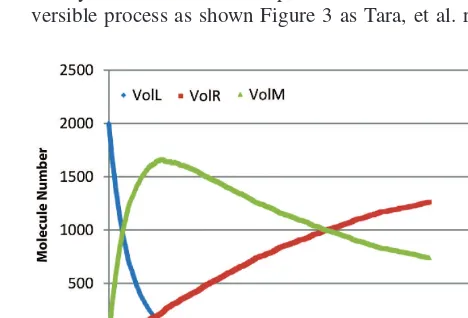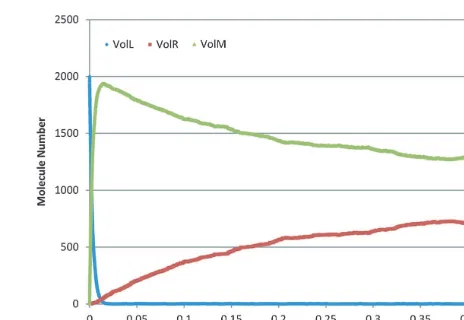Copyright © 2015 American Scientific Publishers All rights reserved
Printed in the United States of America
Article
Advanced Science,
Engineering and Medicine
Vol. 7, 888–891, 2015 www.aspbs.com/asemInvestigation Monte Carlo Simulation for 3 Compartment
Model as Biology System in Urinary
Adita Sutresno
12∗, Freddy Haryanto
1, Sparisoma Viridi
1, and Idam Arif
11Nuclear Physics and Biophysics Research Group, Physics Department, Institute Technology Bandung,
Jl. Ganesa 10, Bandung 40132, Indonesia
2Physics Department, Satya Wacana Christian University, Jl. Diponegoro 52-60, Salatiga 50711, Indonesia
Biology system in our body is very complex. It includes urinary system, which consists of blood, kidney, ureter, bladder and urethra. A simple model using simulation was designed to approach this complex system. This study aimed at implementing the Monte Carlo simulation for investigation the urinary system based on the kinetic theory. MCell as Monte Carlo simulation was used to analyze the compartment model for urinary system. Urinary system was created in two models. One was three compartments with blood and bladder compartment same dimension and another model was with blood compartment smaller than bladder compartment. Simulation with blood and bladder compartment same dimension showed similar result with experiment of renography. The result with blood compartment, smaller than bladder showed the diffusion process faster than another model. This simulation indicated that MCell was acceptable create complex model for urinary system or another biology system.
Keywords:
Monte Carlo, MCell, Urinary.1. INTRODUCTION
The urinary system is one of the important systems in body that function is to produce urine and conducts it to outside the body, which urinary system consists of a pair of kidneys, ureters, bladder and urethra.12Pair of kidneys is the priority organ of excretion that is removal of metabolic waste in the body.
In 2013, Tara, et al.3applied investigation of regulation a urinary system for finding physiology parameter value with four irreversible compartments for the kinetic anal-ysis result of renography. Deeper investigation of urinary system was needed to find a function of compartment in biology system models as blood, kidney and bladder. One outstanding issue was constrained to find a solution for compartment model using more than 2 compartments.
Monte Carlo Simulation is one method to solve that problem. This research used Monte Carlo Cell (MCell) to run simulation which its software was based on Fick’s Law of diffusion process combined with biological process in organ. Its simulation was combined with Blender, which
∗Author to whom correspondence should be addressed.
the Blender was software for designing geometry of com-partment and used to visualize MCell simulation results.
Compartment was used as a model of biology system in urinary for blood, kidney and bladder which blood and bladder compartments smaller than kidney compartment and inside of kidney compartment. Variation of parameter input and dimension of compartment gives much infor-mation about urinary system in body. However, this com-partment model didn’t really represent urinary system in reality.
2. METHOD
Monte Carlo Cell simulation was carried out using MCell 3.14 running on a Lenovo ThinkPad 2.2 GHz Intel Core i7 (Ubuntu 14.10).56Visualization and movies were made from output of MCell using Blender 2.69 which add-on with CellBlender.
This biology system of urinary system was pictured by 3 compartments; blood, kidney and bladder with label L, M and R respectively. The model was illustrated in Figure 1 as a box with dimension of (L) and (R) compart-ment smaller than (M) compartcompart-ment which both inside the kidney compartment. In fact, kidney was the center process
Sutresno et al. Investigation Monte Carlo Simulation for 3 Compartment Model as Biology System in Urinary
Figure 1. Urinary system model with three compartment used in the MCell simulation.
for urinary system. This was a reversible process, which allowed molecules entrance from blood to kidney then returned to blood again or molecules entrance to bladder from kidney then returned to kidney again. Kidney com-partment was bigger than another comcom-partment because it used a single model.
Diffusion constant for both compartment (L and R) was similar. However, inside was different from the sur-face. Inside was 1×10−4 cm2 s−1 and surface had 1× 10−7cm2s−1. Detail parameter was shown in Table I. The simulation process itself needed 2.000 molecules.
Simulations were carried out in two phases. In the first phase, molecule in compartment L (VolL) interacted with molecule on surface L (SurfR) then process diffusion just happened direct to compartment M (VolM) and this pro-cess was reversible. In the second phase, molecule in VolM as result diffusion from VolL interacted with surface molecule on surface VolR (SurfL) and there was diffusion process to VolR. This process was also reversible. All of diffusion processes had higher value of forward rate than the backward. The detail value was shown in Table I, and reaction diagram was shown below.
VolL+SurfR⇋Fr
These simulations were carried out in two different con-ditions of dimensions. The first simulation showed that both dimension of VolL and VolR were similar. The sec-ond, condition of VolL was smaller than VolR.
Table I. Standard value of the parameter used in the simulation.
Parameter Standard value
In the first model, compartment dimension of blood and bladder was smaller than kidney compartment. Kidney compartment was bigger than the other two because kidney was important organs in urinary system process. It made kidney the center process which its process allowed blood flow to kidney and from kidney returned to blood or continued to bladder. Diffusion process took place from L compartment to M compartment which diffusion con-stant of molecule in L compartment was higher than dif-fusion constant of molecule on surface. This process was reversible that the forward rate higher than the backward. It allowed some molecules flow back to blood ment as original source. Molecules from M compart-ment continued to R compartcompart-ment but this process was reversible also.
Figure 2 showed the result simulation of MCell with dimension of L and R compartment was similar. Blue line was molecule in L compartment which its diffusion pro-cess to M compartment and during 0.050 s approached to zero (28 molecules remain) and all molecule transferred at 0.103 s. This process correlated with molecule number in M compartment. The green line showed that molecule number increased suddenly and in the same time the num-ber of L compartment decreased. M compartment reached peak molecule number at 0.032 s with 1660 molecules. When molecule number in L compartment declined nearly zero, it needed longer time than molecule number in M compartment on peak (0.032 s). M molecules declined because they were transferred to R compartment. In other side, red line showed that molecule number of R compart-ment increased slowly, because it received from M com-partment and finally molecule number in R comcom-partment overpassed those in M compartment at 0.140 s. The result clearly shows the reversible process similar from the irre-versible process as shown Figure 3 as Tara, et al. result.
Figure 2. Result simulation of MCell with same dimension of L and R compartment. VolL as molecule inside Compartment L, VolR as molecule inside Compartment R, VolM as molecule inside Compartment M.
Investigation Monte Carlo Simulation for 3 Compartment Model as Biology System in Urinary Sutresno et al.
Figure 3. Graph of solution from equation with initial parameter3base
on experiment renography (with permission).
Figure 3 showed result of experiment model from renog-raphy kinetic analysis. This model used four compartments consist of a blood compartment, two kidney compartment and a bladder compartment and irreversible diffusion pro-cess with reaction propro-cess as shown below. The diffusion process began from compartment L (VolL) as compart-ment of blood to two compartcompart-ments M (VolM1and VolM2) as right and left kidney and finally into compartment R (VolR) as compartment of bladder. The diffusion process in this case was irreversible that meant one way diffusion without any chance reversed diffusion process.
Based on that result, comparison between Figure 2 (using three model compartment with single kidney com-partment and reversible process) and Figure 3 (using four model compartment and irreversible in urinary system) looked similar.
Second model of compartment showed different dimen-sion between L compartment and R compartment which every side (x,y,z) of L compartment had a half of length
of every side of R compartment. Compartment of L had higher concentrations than previous model, because vol-ume of L compartment was smaller with same molecule number 2000. This condition had shown effect of diffusion process from L compartment to M compartment that faster than previous model which blue line shown in Figure 4. It showed molecule number of L compartment was nearly zero (28 molecules remain) at 0.013 s and all molecule transferred at 0.023 s or about 4.46 times faster than pre-vious model.
Green line showed molecule number in M compartment which increased form initial state and reached peak at 0.014 s with 1938 molecules. This result gave information
Figure 4. Result simulation of MCell with different dimension of L and R compartment.
which almost all molecules in this model were transferred to M compartment before transferred to R compartment. This different condition compared to the result of first model which during molecule transferred from L com-partment to M comcom-partment (1660 molecules at 0.032 s was peak of green line in Fig. 2) at the same time had transferred molecules from M compartment to R compart-ment with significant number. This condition showed that molecule transfer process from M compartment to R partment slower than previous and the number in R com-partment was never reached 0.4 s.
4. CONCLUSIONS
Based on result simulation MCell using three compart-ments in reversible diffusion process compared to four compartments in irreversible diffusion process provided good result which both of graph showed similar pattern. The irreversible diffusion process showed that molecules in blood transferred into two kidneys very fast and number of molecules in kidneys increased rapidly than decreased and then molecules number in bladder increased rapidly. This pattern was similar with result in reversible diffusion process model.
The other side, changing dimension gave faster diffu-sion process trans-compartment which this fact showed possibility to calculate duration of diffusion process based on dimension comparison. The compartment model would possibly investigate the complex model such as the urinary system or another biology system.
Acknowledgments: This work was supported by Development Project ITB (III) and JICA (Grand No. 1575/I1.C01/PL/2014) and Research Grand of Foreign Cooperation and International Publication between Lab-oratory of Biophysics, Physics Department, ITB with Laboratory of Hidetaka Arimura, University of Kyushu, Japan.
Sutresno et al. Investigation Monte Carlo Simulation for 3 Compartment Model as Biology System in Urinary
References and Notes
1. S. S. Mader, Understanding Human Anatomy and Physiology, 5th edn., McGraw-Hill, English(2004).
2. E. P. Widmaier, H. Raff, and K. T. Strang, Human Physiology: The Machenisms of Body Function, McGraw-Hill, New York(2014).
3. T. R. Raswan and F. Haryanto, Dynamics nuclear renography kinetic analysis: Four-compartement model for assessing kidney function,
4th International Conference on Advances in Nuclear Science and Engineering, Bali(2013).
4. M. Dittrich, Salk Institute, Multiscale Modeling of Biology Sys-tem, [Online]. Available: http://www.mcell.cnl.salk.edu/. [Accessed 1 August 2014].
5. J. P. Dilger,Biophysics Journal98, 959(2010).
6. J. P. Dilger,Anesthesia and Analgesia117, 792(2013).
Received: 27 October 2014. Accepted: 30 November 2014.

